Sunday Poster Session
Category: Colorectal Cancer Prevention
P0328 - Serum and Plasma Biomarkers for the Screening of Colorectal Cancer: A Systematic Review
Sunday, October 22, 2023
3:30 PM - 7:00 PM PT
Location: Exhibit Hall

Has Audio
- FS
Faris Shweikeh, MD
Cleveland Clinic Akron General
Akron, Ohio
Presenting Author(s)
Faris Shweikeh, MD1, Yuhao Zeng, MD1, Saurav P. Kadatane, MD2, Abdur Rahman Jabir, MD3, Aijaz Sofi, MD1
1Cleveland Clinic Akron General, Akron, OH; 2University of Oklahoma Health Sciences Center, Oklahoma City, OK; 3Wake Forest School of Medicine, Winston-Salem, NC
Introduction: In the United States, the extensive promotion of colorecta cancer (CRC) screening has significantly decreased its mortality rate. The U.S. Preventive Services Task Force now advises adults aged 45 to 75 to undergo regular screening for CRC. Nevertheless, the emergence of a concerning trend where CRC affects younger individuals, particularly early-onset CRC, necessitates the urgent exploration and development of additional non-invasive screening methods.
Methods: This systematic review adhered to the guidelines set forth by the Preferred Reporting Items for Systematic Reviews and Meta-Analysis (PRISMA) guidelines. Two reviewers (F.S. and Y.Z.) conducted an independent review of all the articles (published over the last 3 years), extracting pertinent information and recording it in a spreadsheet. Our search strategy utilized multiple keywords. Our main focus was articles reporting sensitivity, specifity, and AUC-ROC (Area Under the Curve for Receiver Operating Curve).
Results: A total of 142 articles were included. There were 59 articles on protein, 58 on RNA, and 21 on DNA. Of these, 53 articles assessed biomarkers panels. The RNA biomarkers, miR-26a-5p and miR-223-3p, had the highest reported sensitivity/specificity of 100%, each with AUCROC of 1. It was found that the combination of miR-18a, miRNA-21, and miR-92a was best among the RNA panels (sensitivity of 86% and specificity of 90%, AUCROC=0.966). The protein CD10 was found to have the highest values at 96% and 100%, respectively (AUCROC= 0.979). As a DNA marker, NDRG4 methylation had the highest values of 86% and 92% (AUCROC= 0.95), respectively. The most widely studied were miR-21 (6 articles) and mSEPT9 (3 articles). The AUC for miR21 ranged from 0.443-0.94, and the AUC ranged from 0.71-0.89 for mSEPT9.
Discussion: Blood-based biomarkers for colorectal cancer screening are theoretically associated with a high patient participation rate as they are convenient, non-invasive tests. The importance of qualitative/quantitative measures toward that goal and its multiphasic process was emphasized. Panels/combinations of biomarkers had higher sensitivities and specificities, and notable panels had high values for early CRC detection. We find miR-21 and mSEPT9 to be the most heavily studied of all. With the recent trend for CRC to affect the younger population, the race to find a serum or plasma marker for screening is becoming more promising.
Disclosures:
Faris Shweikeh, MD1, Yuhao Zeng, MD1, Saurav P. Kadatane, MD2, Abdur Rahman Jabir, MD3, Aijaz Sofi, MD1. P0328 - Serum and Plasma Biomarkers for the Screening of Colorectal Cancer: A Systematic Review, ACG 2023 Annual Scientific Meeting Abstracts. Vancouver, BC, Canada: American College of Gastroenterology.
1Cleveland Clinic Akron General, Akron, OH; 2University of Oklahoma Health Sciences Center, Oklahoma City, OK; 3Wake Forest School of Medicine, Winston-Salem, NC
Introduction: In the United States, the extensive promotion of colorecta cancer (CRC) screening has significantly decreased its mortality rate. The U.S. Preventive Services Task Force now advises adults aged 45 to 75 to undergo regular screening for CRC. Nevertheless, the emergence of a concerning trend where CRC affects younger individuals, particularly early-onset CRC, necessitates the urgent exploration and development of additional non-invasive screening methods.
Methods: This systematic review adhered to the guidelines set forth by the Preferred Reporting Items for Systematic Reviews and Meta-Analysis (PRISMA) guidelines. Two reviewers (F.S. and Y.Z.) conducted an independent review of all the articles (published over the last 3 years), extracting pertinent information and recording it in a spreadsheet. Our search strategy utilized multiple keywords. Our main focus was articles reporting sensitivity, specifity, and AUC-ROC (Area Under the Curve for Receiver Operating Curve).
Results: A total of 142 articles were included. There were 59 articles on protein, 58 on RNA, and 21 on DNA. Of these, 53 articles assessed biomarkers panels. The RNA biomarkers, miR-26a-5p and miR-223-3p, had the highest reported sensitivity/specificity of 100%, each with AUCROC of 1. It was found that the combination of miR-18a, miRNA-21, and miR-92a was best among the RNA panels (sensitivity of 86% and specificity of 90%, AUCROC=0.966). The protein CD10 was found to have the highest values at 96% and 100%, respectively (AUCROC= 0.979). As a DNA marker, NDRG4 methylation had the highest values of 86% and 92% (AUCROC= 0.95), respectively. The most widely studied were miR-21 (6 articles) and mSEPT9 (3 articles). The AUC for miR21 ranged from 0.443-0.94, and the AUC ranged from 0.71-0.89 for mSEPT9.
Discussion: Blood-based biomarkers for colorectal cancer screening are theoretically associated with a high patient participation rate as they are convenient, non-invasive tests. The importance of qualitative/quantitative measures toward that goal and its multiphasic process was emphasized. Panels/combinations of biomarkers had higher sensitivities and specificities, and notable panels had high values for early CRC detection. We find miR-21 and mSEPT9 to be the most heavily studied of all. With the recent trend for CRC to affect the younger population, the race to find a serum or plasma marker for screening is becoming more promising.
Disclosures:
Faris Shweikeh indicated no relevant financial relationships.
Yuhao Zeng indicated no relevant financial relationships.
Saurav Kadatane indicated no relevant financial relationships.
Abdur Rahman Jabir indicated no relevant financial relationships.
Aijaz Sofi indicated no relevant financial relationships.
Faris Shweikeh, MD1, Yuhao Zeng, MD1, Saurav P. Kadatane, MD2, Abdur Rahman Jabir, MD3, Aijaz Sofi, MD1. P0328 - Serum and Plasma Biomarkers for the Screening of Colorectal Cancer: A Systematic Review, ACG 2023 Annual Scientific Meeting Abstracts. Vancouver, BC, Canada: American College of Gastroenterology.
